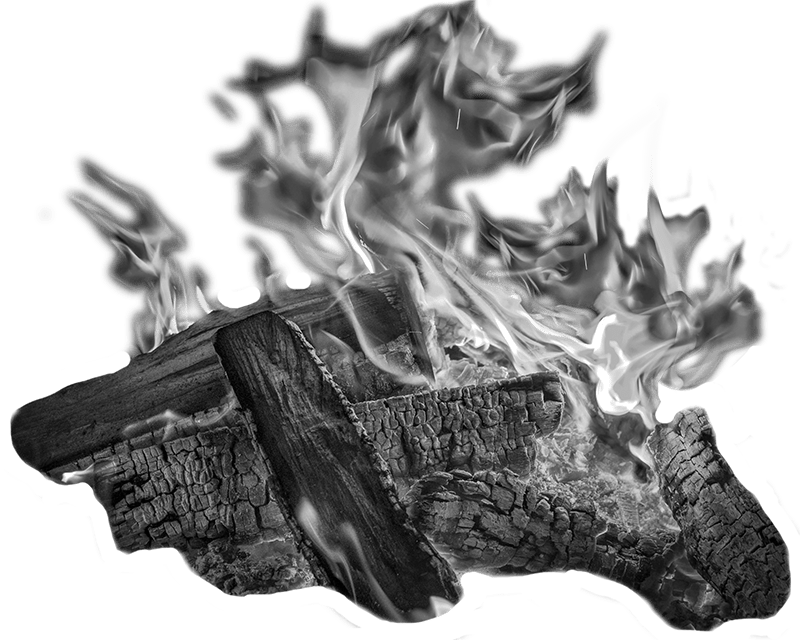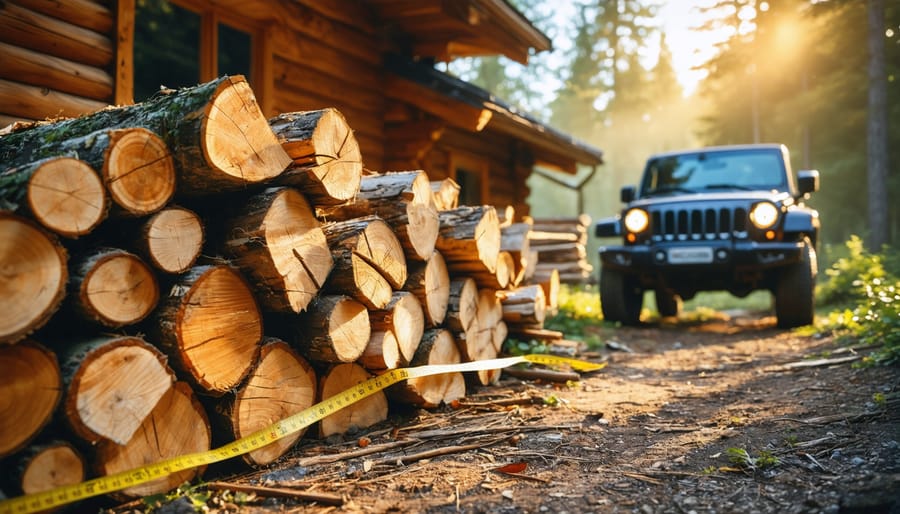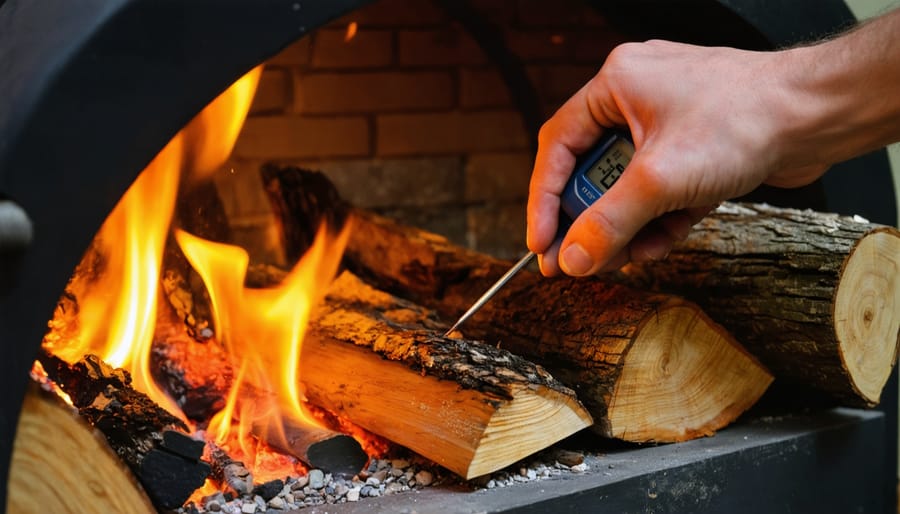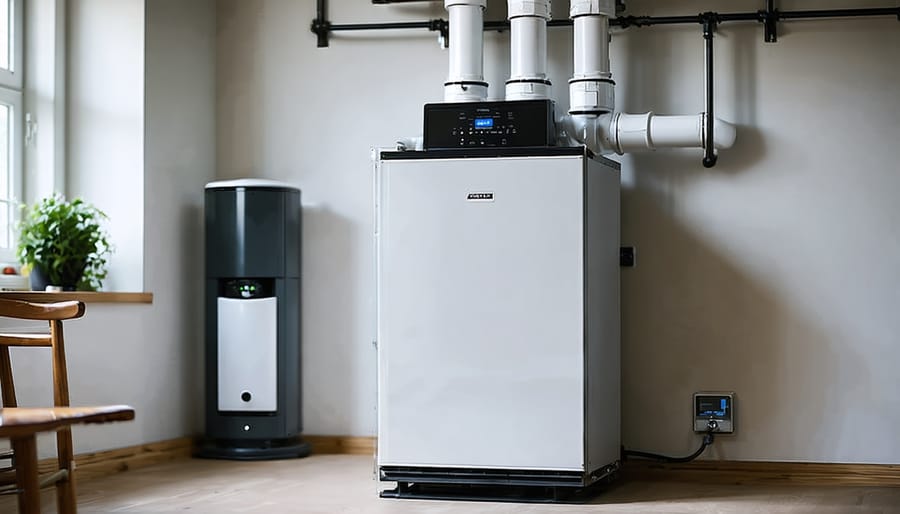Understanding firewood measurements protects your wallet and ensures cozy winter nights without frustration. A full cord—the industry standard—measures exactly 128 cubic feet when properly stacked (4 feet high, 4 feet deep, and 8 feet long), but many sellers advertise “face cords,” “ricks,” or “truckloads” that contain significantly less wood at similar prices. Learn to measure stacked wood yourself by multiplying length × width × height, then divide by 128 to calculate actual cord volume. Watch for loosely stacked deliveries with excessive air gaps, wood pieces longer than 16-18 inches that won’t fit standard fireplaces, or vague quantity descriptions that avoid the word “cord” entirely. Before purchasing, always ask your supplier to specify the exact cubic feet you’re receiving and the piece length, then request they stack the wood during delivery so you can verify measurements together. This knowledge transforms you from an uncertain buyer into a confident consumer who gets full value for every heating dollar spent, keeping your home warm and your fireplace crackling with properly measured, quality firewood all season long.
Why Firewood Measurement Matters More Than You Think
If you’ve ever ordered firewood only to feel like the delivered pile looks smaller than expected, you’re not alone. Understanding firewood measurement isn’t just about numbers—it’s about protecting your investment and ensuring your home stays cozy throughout the heating season.
Here’s the reality: the firewood industry lacks consistent regulation in many areas, creating opportunities for less-than-honest sellers to take advantage of unknowing buyers. Without standardized oversight, you might pay for a “full cord” and receive significantly less. In fact, studies have shown that firewood fraud costs consumers millions annually, with short deliveries being one of the most common complaints.
The financial impact adds up quickly. A genuine cord of seasoned hardwood typically costs between $200 and $400, depending on your region. If you’re shorted by just 25%—which happens more often than you’d think—you’re essentially losing $50 to $100 per order. Over a heating season where you might purchase multiple cords, that’s money disappearing from your household budget.
Beyond the dollars and cents, there’s a practical element too. Underestimating your firewood needs means running out mid-winter, often when prices spike and availability drops. It disrupts the warm, inviting atmosphere you’ve created in your home and can leave you scrambling for alternatives during the coldest months.
Knowledge truly is power here. When you understand what a cord actually measures, how to verify your delivery, and what questions to ask suppliers, you transform from a vulnerable customer into a confident buyer. You’ll recognize quality wood, spot suspicious pricing, and build relationships with honest suppliers who value your business—ensuring your fireplace remains the heart of your home all season long.
The Cord: The Standard Unit You Need to Know
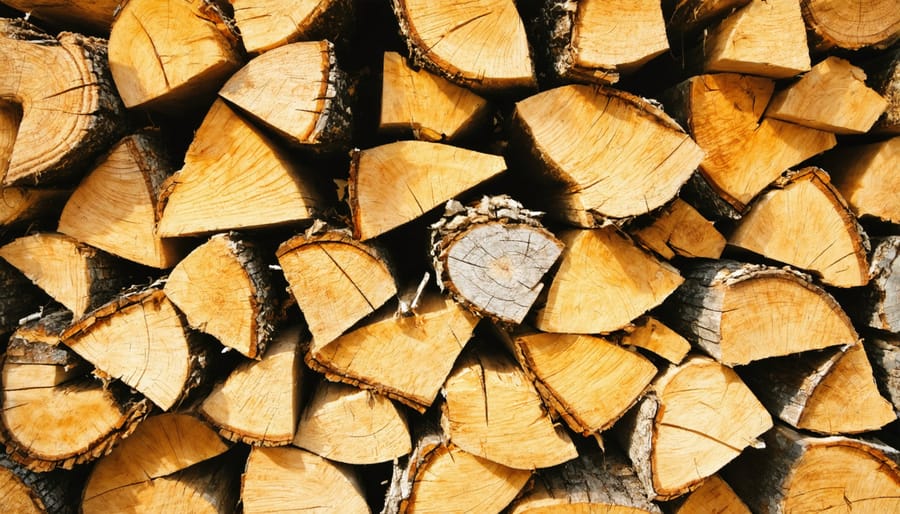
Face Cords, Rick, and Other Confusing Terms
If you’ve been shopping for firewood, you’ve probably encountered terms like “face cord,” “rick,” or “run” that left you scratching your head. These regional variations create unnecessary confusion—and unfortunately, sometimes that confusion works in the seller’s favor rather than yours.
Here’s what you need to know: these terms typically refer to a stack of wood that’s 4 feet high and 8 feet long, but with varying depths. A face cord is usually one-third of a full cord, meaning the pieces are stacked 16 inches deep instead of the full 48 inches. A rick follows the same principle—you can learn more about what a rick is and how it compares. A “run” is yet another regional term meaning roughly the same thing.
The problem? None of these measurements are standardized. A face cord in Tennessee might differ from one in Oregon. The wood length can vary from 12 to 24 inches, dramatically changing how much firewood you’re actually getting for your money.
This is precisely why sticking with the legal definition of a full cord protects you as a buyer. When sellers use alternative terms, always ask them to convert it to cord measurements. A reputable dealer will gladly clarify exactly how many cubic feet or what fraction of a cord you’re purchasing. If they can’t—or won’t—provide that clarity, it’s a red flag worth heeding before you commit to a purchase.
What a Cord Actually Looks Like in Your Driveway
When a full cord arrives at your home, it’s more substantial than most people expect—and that’s a good thing! Picture a neatly stacked wall of wood that stretches 8 feet wide and 4 feet tall, standing about waist-high to chest-high on most adults. The depth of 4 feet means this stack is typically as deep as the length of a single log piece.
To put it in perspective, a properly stacked cord takes up roughly the same footprint as a small motorcycle or garden shed base. If you park your car in a standard garage, a cord would occupy about one-third of that parking space when stacked against a wall.
Here’s a helpful visualization trick: if you stand with your arms outstretched, fingertip to fingertip, you’re measuring approximately 5-6 feet—pretty close to the width of a cord. The stack should come up to about shoulder height, creating an impressive wall of warmth-to-be.
When your delivery arrives, don’t be surprised by how solid and substantial it looks. That’s exactly what you want for a winter’s worth of cozy fires. A genuine cord represents serious heating potential—typically enough to keep a fireplace burning steadily throughout several cold months, making it a worthwhile investment in your home’s comfort and ambiance.
How to Measure Firewood When It’s Delivered
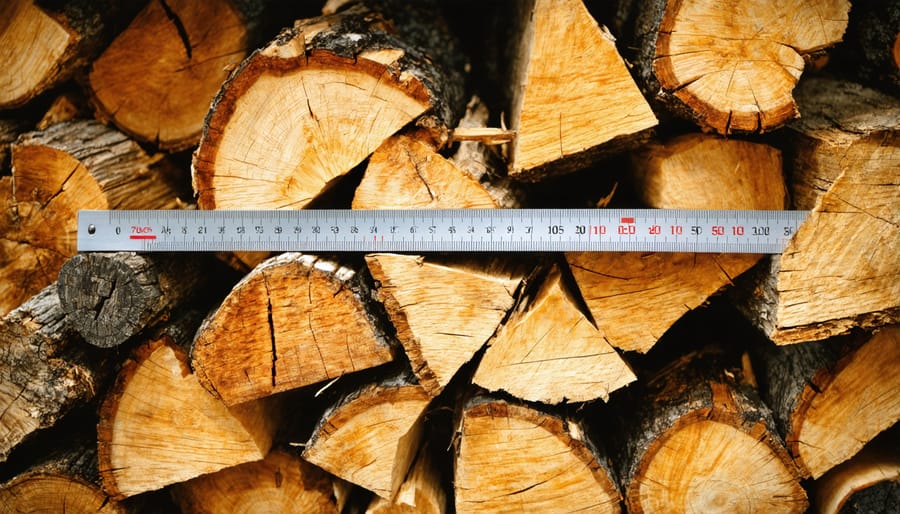
The Quick Stack-and-Measure Method
Measuring your stacked firewood is refreshingly straightforward once you know the formula. Simply multiply the length times height times width (all in feet), then divide by 128. That final number tells you exactly how many cords you have. For example, if your woodpile measures 8 feet long, 4 feet high, and 4 feet wide, you’d calculate: 8 × 4 × 4 = 128 cubic feet ÷ 128 = 1 full cord.
Here’s the beauty of this method—it works whether you’re checking a delivery or planning your wood storage needs for the season. Just remember that all measurements need to be in feet for accuracy. If your stack is 6 inches high, convert that to 0.5 feet before calculating.
For irregular stacks, measure the average dimensions. If one end is 5 feet high and the other is 3 feet, use 4 feet as your height. While proper stacking techniques make measurement easier, real-world woodpiles aren’t always perfect rectangles, and that’s okay.
A helpful tip: always measure after the wood has settled for a day or two. Freshly dumped wood often compacts slightly as pieces shift into place. This approach ensures you’re getting accurate numbers that reflect what you’ll actually burn throughout those cozy evenings by the fire. Keep a tape measure in your garage specifically for this purpose—it’s your best tool for confirming you’re receiving fair value.
Loose vs. Stacked: Understanding Volume Differences
Here’s an important reality check for your next firewood delivery: loose-thrown wood takes up significantly more space than neatly stacked wood—typically 25-30% more. Think of it like packing a suitcase: carefully folded clothes fit more compactly than items just tossed in.
When firewood is dumped loosely into a truck bed or pile, air pockets form between the pieces. These gaps mean you’re actually getting less wood than the visual volume suggests. A pickup truck bed filled with loosely thrown wood might only equal about three-quarters of a cord when properly stacked.
This matters when measuring deliveries. If a supplier quotes you a price for “a cord” but dumps it loose, you’ll need to account for this difference. The honest approach? Ask if the measurement is for stacked or loose wood before purchasing.
To verify what you’re getting, stack a portion of your delivery and measure it. If you ordered a full cord (128 cubic feet stacked), expect your loose pile to initially occupy around 165 cubic feet. Understanding this difference protects your investment and ensures you’re keeping your home warm all season without overpaying. Most reputable suppliers will clearly communicate whether their pricing reflects stacked or loose measurements—it’s a fair question that shows you’re an informed buyer.
Red Flags That You’re Being Shortchanged
When you’re ready to purchase firewood, knowing what to watch for can save you both money and frustration. Unfortunately, not all sellers operate with the same integrity, and some warning signs can help you spot a questionable deal before your wallet takes a hit.
**Vague or creative terminology** is often the first red flag. If a seller uses terms like “truckload,” “rack,” “face cord,” or “running cord” without clarifying exactly what they mean in standard measurements, proceed with caution. These terms vary wildly by region and seller, and what one person calls a “cord” might be only half that amount. A reputable seller should always be willing to explain their measurements in terms of the standard full cord—128 cubic feet of stacked wood.
**Refusal to provide specific measurements** is an even bigger concern. If a seller becomes evasive, defensive, or simply won’t give you dimensions when asked, that’s a clear sign something isn’t right. Honest firewood suppliers understand that educated customers ask questions, and they’re happy to provide clarity. If you’re met with vague assurances like “it’s a good amount” or “you’ll be happy with it,” trust your instincts and look elsewhere.
**Suspiciously low prices** might seem like a bargain, but they often indicate you’re getting less wood than advertised. While everyone loves a deal, firewood prices generally fall within a predictable range for your area. A price significantly below market value usually means smaller quantities, unseasoned wood, or hidden fees.
Finally, **pay attention to the delivery truck**. A pickup truck bed simply cannot hold a full cord of firewood—the math doesn’t work. If someone claims they’re delivering a cord in a standard pickup, you’re likely getting shortchanged by half or more.
Beyond Volume: Other Measurements That Affect Value
Moisture Content and Why It Matters
Moisture content is one of the most important factors that determines how well your firewood will burn—and whether you’re getting true value for your money. Fresh or “green” wood can contain up to 50% water by weight, which means you’re essentially paying for water that will hiss and sputter rather than produce welcoming warmth.
Properly seasoned firewood, with moisture content below 20%, burns hotter, cleaner, and more efficiently. It ignites more easily, produces significantly less smoke and creosote buildup in your chimney, and generates more heat per log. From an eco-friendly perspective, drier wood also releases fewer pollutants into the air, making it better for both your home and the environment.
Here’s where measurement becomes particularly relevant: wet wood weighs considerably more than seasoned wood due to its water content. While a cord of green wood might seem like a bargain by weight, you’re actually getting less usable fuel. Seasoned wood may weigh less when delivered, but it delivers far superior performance and represents genuinely better value for creating that cozy ambiance you’re seeking in your home.
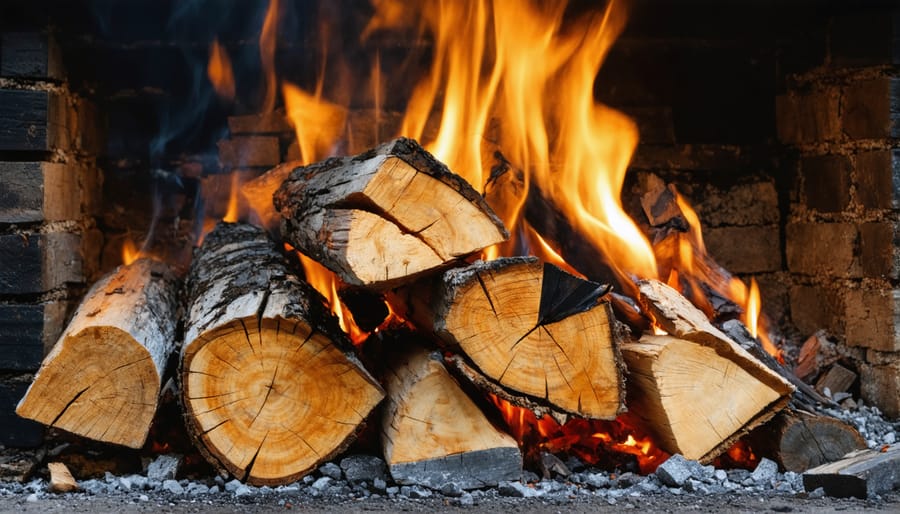
Piece Length and Your Fireplace Size
Choosing the right piece length is about more than just measurements—it’s about creating a seamless, enjoyable fireside experience. Standard firewood typically comes in 16-inch, 18-inch, or 24-inch lengths, and your fireplace dimensions should guide your choice.
Here’s a simple rule: your firewood pieces should be at least 3-4 inches shorter than your firebox depth. This allows for proper air circulation and safer burning. If your firebox is 20 inches deep, 16-inch pieces are your sweet spot. Trying to cram oversized logs into your fireplace isn’t just frustrating—it creates inefficient burns and potential safety hazards.
Piece length also dramatically affects how efficiently you can stack and store your wood. Uniform 16-inch pieces stack beautifully and fit neatly into most firewood racks, while mixed lengths create awkward gaps and wasted space. When ordering, always confirm the exact cut length with your supplier. Some vendors measure generously, while others cut short, and those few inches make a real difference in both your fireplace performance and your storage efficiency.
Smart Questions to Ask Before You Buy
Walking into a firewood purchase armed with the right questions transforms you from an uncertain buyer into a confident consumer. Think of these inquiries as your shield against common industry practices that can leave you with less wood than you’re paying for.
Start with the fundamentals: “What measurement unit are you using—cord, face cord, or something else?” This simple question immediately signals you’re an informed buyer. Follow up with, “Can you tell me the exact dimensions in feet?” A legitimate supplier will gladly confirm they’re selling a full cord at 4×4×8 feet or explain precisely what their measurements mean.
Next, address the delivery details: “Will the wood be stacked or dumped loose?” This matters tremendously because loose wood can appear to be much more volume than it actually measures when stacked. If they’re delivering loose, ask, “How do you account for the air gaps in your pricing?” Fair suppliers often deliver 10-15% extra to compensate.
Don’t skip the wood quality questions. “What species are included, and what’s the seasoning time?” connects directly to your eco-friendly heating goals—properly seasoned hardwoods burn cleaner and more efficiently than green wood. Ask for “under 20% moisture content” as your target.
Finally, discuss verification: “Can I measure the wood before unloading?” or “Do you provide a receipt with exact measurements and wood type?” These questions establish accountability and show you understand your rights as a consumer.
Remember, reputable firewood suppliers welcome these questions—they’re proud of their product and measurement practices. If anyone seems defensive or evasive, that’s your cue to find another supplier. Your home’s warmth deserves transparency and honesty from the very first conversation.
Making Your Firewood Budget Go Further
Getting the most value from your firewood investment doesn’t require complex strategies—just smart planning and a few practical habits. Think of it as creating a sustainable rhythm that keeps your home cozy without breaking the bank.
Start by purchasing during the off-season, typically late spring through early summer. Prices can drop 20-30% when demand is low, and you’ll have better selection from suppliers. Buying in bulk—a full cord or more—also typically reduces your per-unit cost significantly.
Proper storage protects your investment by maintaining wood quality and preventing waste. Well-seasoned wood that gets wet or sits improperly can develop mold or rot, essentially turning money into mulch. Keep your firewood covered, elevated off the ground, and allow airflow between pieces.
Consider mixing wood types strategically to balance cost and performance. Hardwoods like oak burn longer but cost more, while softer woods like pine ignite easily and cost less. Use pine for kindling and quick warmth, then transition to hardwoods for sustained heat during longer evenings.
The key to avoiding overpurchasing or running short mid-winter is calculating seasonal needs based on how frequently you burn fires. Track your usage for one season, and you’ll have a reliable baseline for future years. This mindful approach transforms firewood from an uncertain expense into a predictable part of your home’s comfort budget—one that enhances both ambiance and warmth throughout the colder months.
Armed with the right knowledge about firewood measurements, you’re now ready to confidently purchase your winter supply without second-guessing whether you’re getting a fair deal. Understanding what a true cord looks like, knowing how to verify your delivery, and asking the right questions transforms you from an uncertain buyer into an informed consumer who protects their heating investment.
There’s something deeply satisfying about a well-stacked woodpile—knowing exactly what you have and that you paid a fair price for quality fuel. This knowledge doesn’t just save you money; it enhances your entire fireplace experience, ensuring you have the right amount of properly measured wood to keep your home warm and inviting throughout the season. By purchasing responsibly and understanding measurements, you’re also supporting sustainable heating practices that benefit both your household and the environment. Now it’s time to enjoy those cozy evenings by the fire, confident that your woodpile will deliver exactly the warmth and ambiance you deserve.
